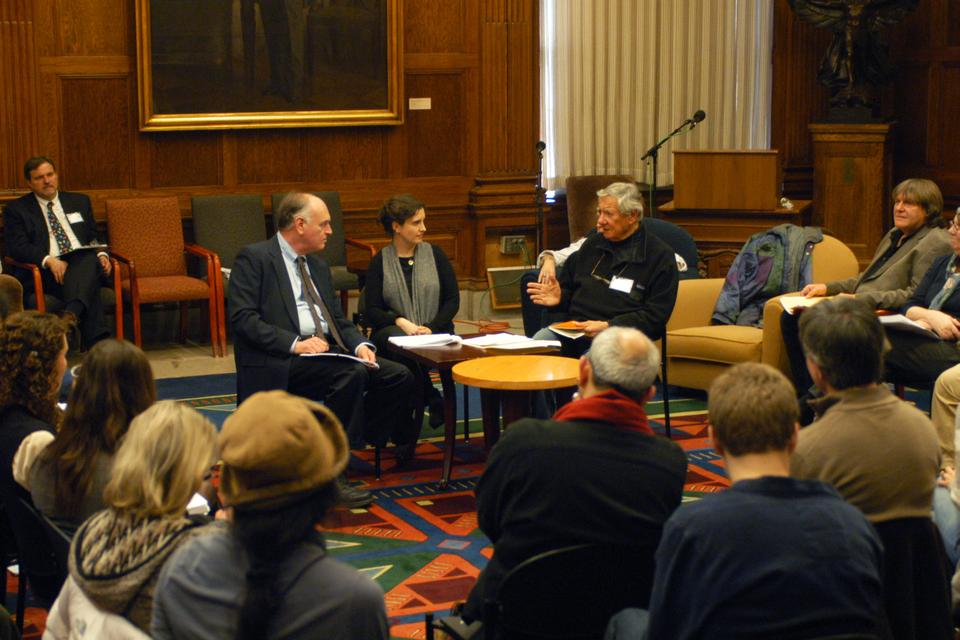
News
Summers Will Not Finish Semester of Teaching as Harvard Investigates Epstein Ties

News
Harvard College Students Report Favoring Divestment from Israel in HUA Survey

News
‘He Should Resign’: Harvard Undergrads Take Hard Line Against Summers Over Epstein Scandal

News
Harvard To Launch New Investigation Into Epstein’s Ties to Summers, Other University Affiliates

News
Harvard Students To Vote on Divestment From Israel in Inaugural HUA Election Survey
Top Experts Explore Strindberg’s Work
Two-day Symposium celebrates the work of influential Swedish modernist playwright Strindberg.

“If a bomb went off in this room at this moment, the cause of Strindberg would be set back a century,” one monocle-clad audience member observed as a crowd of scholars shuffled into the Barker Center’s Thompson Room on Friday afternoon. The group, a collection of translators, directors, professors, and filmmakers, had gathered for the Harvard Strindberg Symposium. To distinguish it from similar academic events, the symposium was filled with both critical and performative reinterpretations designed to show its enduring depth and broad relevance of Strindberg’s work. “Modern theater would not have existed without him. That’s a fact,” said Ursula A.L. Lindqvist, preceptor for Scandinavian languages and director of Undergraduate Studies for Scandinavian.
August Strindberg, as Lindqvist explained during the first lecture, was a Swedish writer whose enormous body of work has always had a complicated critical reputation. He is usually thought of as a misogynist, and his attitude towards women has became so infamous that Woody Allen has quipped about it in his 1979 film “Manhattan.” Lindqvist, however, believes that focusing on this specific reading of his character is unfair. “It’s not desirable or responsible to label Strindberg a misogynist,” she said. “It is undeniable that today Strindberg remains one of the great modernists.”
These underappreciated strains were addressed in lectures given by Harvard Professor Martin Puchner and University of Illinois Professor Anna Westerståhl Stenport. Puchner, who discussed the 1903 play “Hellas,” identified the Swede as a modern champion of the philosophical drama that originated with Plato’s Socratic dialogues.
Stenport’s speech, which focused on the 1901 play “Dance of Death,” was a more explicit attempt to move away from the criticism that has colored Strindberg’s work; as she noted, the somewhat reductive interpretations that emerged upon the work’s premiere have persisted to this day. “The marriage drama plot, the religious conversion plot—it’s there, but there’s so much more,” Stenport said. Her speech examined how the play’s harsh social critique, layed out in a highly expressionistic manner, has not been examined in traditional studies of the work. By examining historical evidence, she was able to convincingly claim that the play’s unorthodox set design was meant to evoke late 19th century prisons.
Such critical reevaluations were augmented by one of the most distinctive elements of the symposium: the inclusion of staged readings of Strindberg’s work. Excerpts from ”Hellas” and “Dance of Death” preceded Puchner’s and Stenport’s lectures and gave their claims context. Lindqvist feels that these performances were an integral part of the symposium. “We’re actually showcasing the creative work, which is the reason we’re all here,” says Lindqvist. “What better way to understand Strindberg than to come in contact with his work directly?”
These performances served another purpose; as David R. Grieder ’14, who helped publicize the event, explained, they are one of several elements in the symposium designed to appeal to undergraduates. For Lindqvist, getting students excited was a major goal of the event. While researching previous Strindberg events at Harvard, she discovered that in the middle of the 20th century students used to frequently stage his plays at venues such as the Loeb Ex. Since then, however, that interest has been lost. “Since the 1960s, he has definitely not been at the forefront of student consciousness. We need to reintroduce Strindberg,” Lindqvist said.
Ture Rangström, artistic director at the Intima Teatern in Stockholm, Sweden, feels that Strindberg is growing in popularity among the youth because of his modernist aesthetic. “Young directors want to do Strindberg because they feel he is more free, more experimental,” he says. Strindberg’s work was explored by radical reinterpretations of his plays, as well as more conventionally staged scenes. Filmmaker and choreographer Gabrielle Lansner, for instance, showed her short film “The Stronger,” which explores Strindberg’s eponymous 1889 play through the medium of dance. Other interpretations were discussed by scholar Victor Grovas, who spoke about Mexican stagings of Strindberg, including versions done by the cult filmmaker Alejandro Jodorowsky.
What was most compelling about Grovas’s speech was how it displayed the universal appeal of Strindberg’s work, despite his tarnished critical reputation. These sentiments were shared by Grieder. “The longer I worked on it, the more I realized its magnitude,” he says. “People are going wild in Sweden right now for the centennial of his death.” Details such as this abounded at the symposium, and showcased a desire to revive popular interest in Strindberg. “If you make a symposium like this, this is how it starts,” Rangström said, smiling.
—Staff writer Petey E. Menz can be reached at menz@college.harvard.edu.
Want to keep up with breaking news? Subscribe to our email newsletter.
